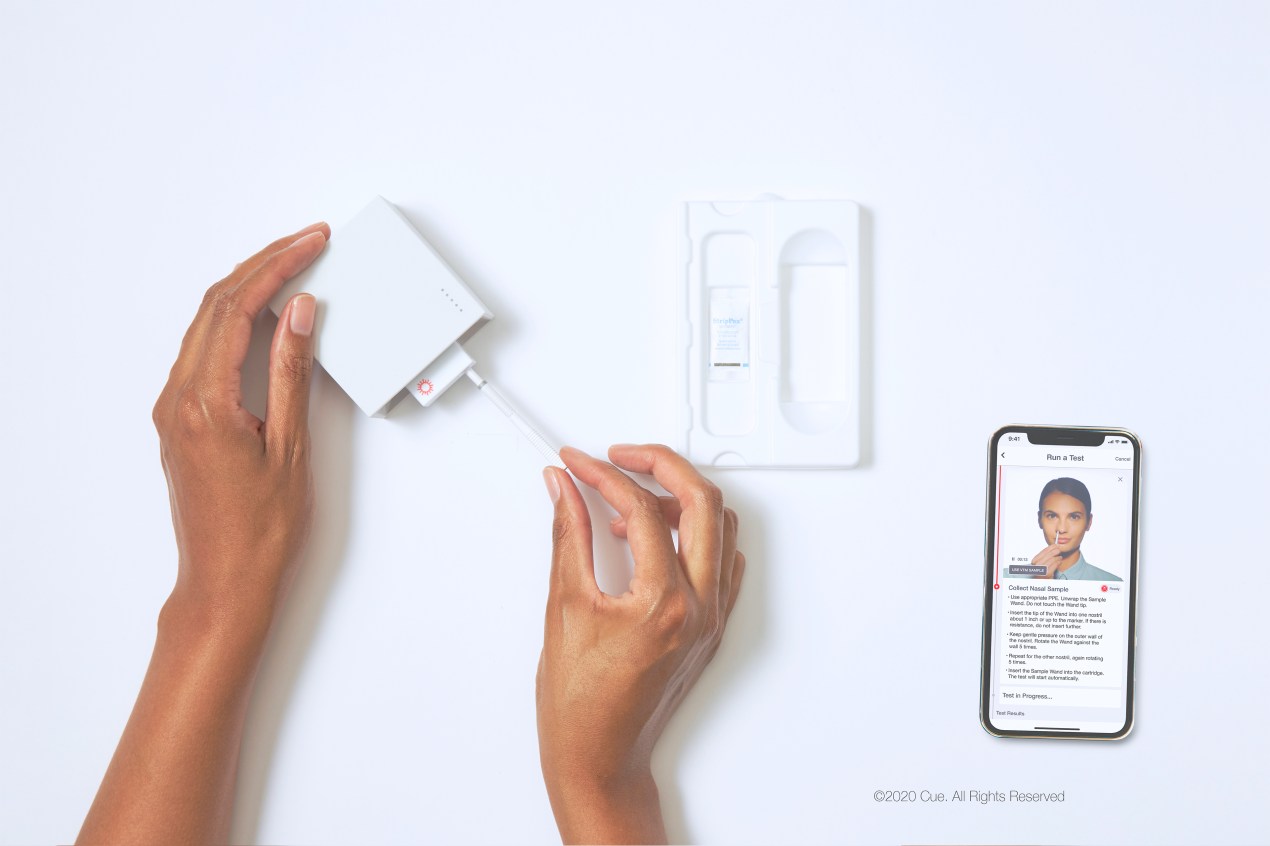“I’ve got this,” coos Gal Gadot in Cue Health’s Super Bowl TV commercial. Cue hired the “Wonder Woman” actress to be the voice of the company’s new high-tech covid-19 testing device. The ad pushes the notion that the at-home covid test produces results equal in accuracy to a lab-based PCR test and surpasses it in convenience.
What it doesn’t mention is the price: $249 for the reusable device and $195 for a pack of three tests.
Even as the number of covid cases waned during the winter, many people who saw the ads wondered whether the device — no matter how convenient or technologically wondrous it might be — has the right approach. High-tech startups eager to disrupt the health care industry are relying on a tried-and-true marketing strategy: price it high for early adopters and then lower the price as the market grows.
To take the Cue test, users swab their nostrils with a special wand, insert the wand into a cartridge, and then the cartridge into a white, cube-shaped reader. Within 20 minutes, results are transmitted via Bluetooth to Cue’s smartphone app. Those who purchase a $900 annual subscription can access a physician via the app, to certify the results as valid for travel or other purposes.
A highly accurate at-home covid test certainly has its advantages. And Cue, a publicly traded company based in San Diego, says that 97.8% of the time its test results agreed with a positive PCR lab test result, still considered among the most accurate. (The price of a PCR test varies but can be $100 or more, and results usually take at least 24 hours, though quicker results can be obtained for more money.)
But even the cheapest pricing — yearlong subscriptions, which begin at $480 for 10 tests (and a discounted device for $149) — is considerably more than the cost of less-accurate antigen tests, which Americans can now often procure at no cost.
Cue’s price puts it out of the reach of most consumers. But it fits an elite business model that seeks to attract attention and assumes that the price will drop at some point as the market grows and demand rises.
For now, unless employers provide them, consumers must foot the bill for the Cue tests because health insurance companies, which generally cover lab-based PCR tests and rapid antigen tests, do not reimburse policyholders for the Cue system. “We are proactively working with health insurance companies to get coverage for Cue Health solutions,” said Dan Bank, a company spokesperson. But the company has yet to announce an arrangement with any insurer.
Although Cue’s Super Bowl commercial implies that its testing product is aimed for the at-home user, its biggest customer has been the Department of Defense, although its government contract has ended. The test has also been picked up by sports leagues and commercial enterprises buying units for their employees, including Major League Baseball, the National Basketball Association, Netflix, and Google.
In the first quarter of 2022, non-government revenue grew to 98% of sales, or $175.8 million out of a total of $179.4 million. Net income for the quarter was $2.8 million, compared with $13 million for the same quarter last year, as the company stepped up spending on personnel, marketing, and product development. Second-quarter revenue is also expected to drop, the company said, falling to about $50 million.
The company, which sold stock to the public last year, has seen its share price (enviable stock symbol HLTH) drop from $22 at its September debut to around $5.
The company’s other, even more basic, problem is that fewer people are interested in getting tested for covid regularly. “There was enthusiasm when covid was in full swing, but now that people sense the omicron strain is not so bad, the focus on testing has changed,” said Charles Rhyee, an analyst with Cowen. (Cowen, a Wall Street investment firm, helped take Cue public but does not have a financial relationship with the company.)
It’s possible, he said, that Cue is like other companies that zoomed during the pandemic only to fall to Earth. “The company is already looking like Peloton, and a lot of that feeling is already baked into the price of the stock,” Rhyee said.
Cue points out that covid testing is just the first use of its product. It wants to develop and receive FDA approval for other tests that can use the $249 device, including for flu; respiratory syncytial virus, or RSV; fertility; and pregnancy. If a flu test came back positive, Cue officials said, the smartphone app might be able to connect the patient to a physician early enough to receive the benefit from taking an anti-flu medication such as Tamiflu.
“Just like at-home pregnancy tests completely changed how women get answers and glucose meters forever changed how diabetics monitor their glucose levels, we think the paradigm has permanently shifted for infectious disease testing at home, and Cue is well positioned to meet these needs,” Bank said.
Yet none of those tests will be available or generate any income in 2022. The company expects to submit tests for influenza A and B in late summer or autumn. The company has pointed out that the speed at which it can evaluate new kinds of tests to offer the FDA could be adversely affected by the prevalence of covid, potentially limiting its ability to find test subjects or have personnel in its facilities.
To increase sales, the company in February lowered the cost of its monthly subscription and individual tests by $15.
But Charles Rhyee thinks much bigger price cuts are needed for success. The short-term solution, he said, is for Cue to offer its reader device at low or no cost and make its money from tests, using a classic marketing technique that predated the high-tech era by nearly a century: the razor-razor blade model, in which the real money is made on high-priced blades after selling customers a cheap proprietary handle to hold them.







